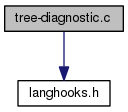Unwind the different macro expansions that lead to the token which
location is WHERE and emit diagnostics showing the resulting
unwound macro expansion trace. Let's look at an example to see how
the trace looks like. Suppose we have this piece of code,
artificially annotated with the line numbers to increase
legibility:
$ cat -n test.c
1 #define OPERATE(OPRD1, OPRT, OPRD2) \
2 OPRD1 OPRT OPRD2;
3
4 #define SHIFTL(A,B) \
5 OPERATE (A,<<,B)
6
7 #define MULT(A) \
8 SHIFTL (A,1)
9
10 void
11 g ()
12 {
13 MULT (1.0);// 1.0 << 1; <-- so this is an error.
14 }
Here is the diagnostic that we want the compiler to generate:
test.c: In function ‘g’:
test.c:5:14: error: invalid operands to binary << (have ‘double’ and ‘int’)
test.c:2:9: note: in definition of macro 'OPERATE'
test.c:8:3: note: in expansion of macro 'SHIFTL'
test.c:13:3: note: in expansion of macro 'MULT'
The part that goes from the third to the fifth line of this
diagnostic (the lines containing the 'note:' string) is called the
unwound macro expansion trace. That's the part generated by this
function. Let's unwind the macros that got expanded and led to the token
which location is WHERE. We are going to store these macros into
LOC_VEC, so that we can later walk it at our convenience to
display a somewhat meaningful trace of the macro expansion
history to the user. Note that the first macro of the trace
(which is OPERATE in the example above) is going to be stored at
the beginning of LOC_VEC. WHERE is the location of a token inside the expansion of a
macro. MAP is the map holding the locations of that macro
expansion. Let's get the location of the token inside the
context that triggered the expansion of this macro.
This is basically how we go "down" in the trace of macro
expansions that led to WHERE. Now map is set to the map of the location in the source that
first triggered the macro expansion. This must be an ordinary map. Walk LOC_VEC and print the macro expansion trace, unless the
first macro which expansion triggered this trace was expanded
inside a system header. Sometimes, in the unwound macro expansion trace, we want to
print a part of the context that shows where, in the
definition of the relevant macro, is the token (we are
looking at) used. That is the case in the introductory
comment of this function, where we print:
test.c:2:9: note: in definition of macro 'OPERATE'.
We print that "macro definition context" because the
diagnostic line (emitted by the call to
pp_ouput_formatted_text in diagnostic_report_diagnostic):
test.c:5:14: error: invalid operands to binary << (have ‘double’ and ‘int’)
does not point into the definition of the macro where the
token '<<' (that is an argument to the function-like macro
OPERATE) is used. So we must "display" the line of that
macro definition context to the user somehow.
A contrario, when the first interesting diagnostic line
points into the definition of the macro, we don't need to
display any line for that macro definition in the trace
anymore, otherwise it'd be redundant. Okay, now here is what we want. For each token resulting
from macro expansion we want to show: 1/ where in the
definition of the macro the token comes from; 2/ where the
macro got expanded. Resolve the location iter->where into the locus 1/ of the
comment above. Don't print trace for locations that are reserved or from
within a system header. We need to print the context of the macro definition only
when the locus of the first displayed diagnostic (displayed
before this trace) was inside the definition of the
macro. At this step, as we've printed the context of the macro
definition, we don't want to print the context of its
expansion, otherwise, it'd be redundant. Resolve the location of the expansion point of the macro
which expansion gave the token represented by def_loc.
This is the locus 2/ of the earlier comment.

